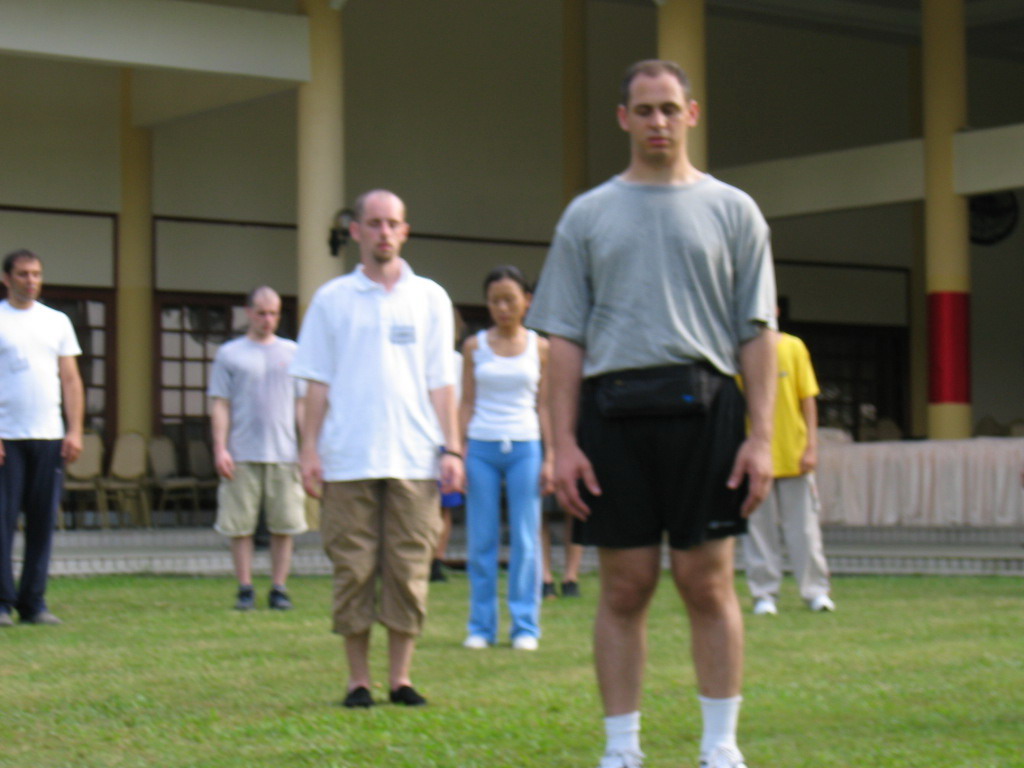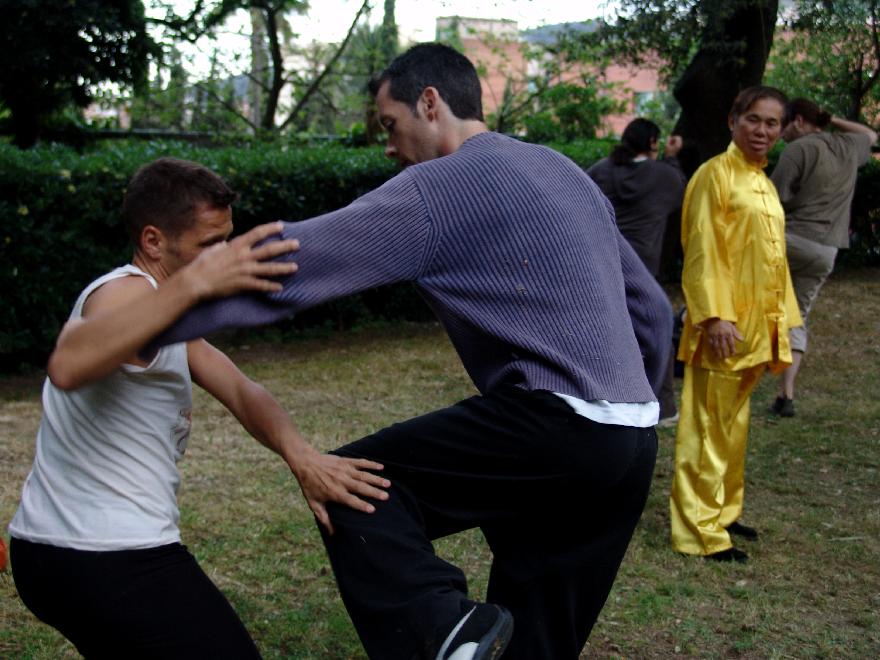EXAMPLES OF INTELLECTUAL QUESTIONS

During Standing Meditation after some vigorous kungfu training, we feel inner peace, happiness and a tremendous sense of freedom.
Question
I have been studying Shaolin martial arts for some time now and have for the last few years been trying to better understand the Shaolin monastic tradition.
Many books have been written that discuss that monks practiced mediation, purification and mental discipline but I have found little on the methodology, structure, language and cosmology of that process. It occurs to me that a better understanding of these things will give rise to a better understanding of the heritage, culture and forms that we practice.
— Wayne, USA
Answer
Your questions, while interesting, are like those that prompted the great Bodhidharma, the First Patriarch of the Shaolin arts, to ask the monks to burn their books and focus on their practice.
One should note it was not that Bodhidharma was against book learning but book learning alone, while providing useful intellectual knowledge and which the monks were doing to the extent of neglecting their practical application, would not help the monks to attain their goal, i.e. Enlightenment.
It also strikes me that you are too captivated by words alone, without actually being aware of what you really want to say. For example what do your really mean by “the methodology, structure, language and cosmology of that process”? By “that process” do you refer to the meditation, purification or mental discipline the monk did, or to the writing of many books, or to the discussion on the monks' practice?
Moreover, what do you mean by “these things” which you seek a better understanding? What is it that you (or we) practice? Do you mean you need a better understanding of the methodology, structure, language and cosmology of meditation before you can better understand the heritage, culture and forms of whatever you practice? Or do you mean that you need a better understanding of the whole process of what you say before you can better understand meditation? These are only some of many possible meanings of what you say.
Until you are clear of what you mean, it would not be meaningful to comment on your statement or answer your implied question to your satisfaction.
But the irony is that irrespective of your intended meanings of the words you use, and even when satisfied answers are given to you, you will still not have a better understanding of the meditation, purification, mental discipline of the monks, or of Shaolin martial arts or the Shaolin monastic tradition.
Although pages or even volumes can be written for the explanation, it can be briefly summed up in one paragraph as follows.
You are concerned with intellectualization. While intellectualization may provide some mental pleasure (or confusion), it cannot enable you to have a better understanding of the issue in question, irrespective of whether the issue is Shaolin martial arts, the Shaolin monastic tradition, meditation or something else. It is because these issues concern practical experience. Unless you have practical experience, you would not understand what is being described or explained even though the description or explanation is accurate.
Another two paragraphs of elaboration may make my point clearer.
In the Shaolin martial arts, for example, no matter how well a Shaolin master may describe internal force training, unless you have actually practiced and experienced internal force, you will not know what it is. In the Shaolin monastic tradition, no matter what structure is used to describe it, unless you have practiced and experienced it, you will not know what it is.
In meditation, no matter the language used to describe it is simple or profound, in English or in Chinese, unless you have practiced it, you will not know what meditation is. No matter what form of cosmology you may force it into the Shaolin arts, Shaolin monastic tradition or meditation, and how well or badly you describe the process, unless you have practical experience of the arts, tradition or meditation, you will have no understanding of them.

Shaolin martial arts are naturally developed for martial purposes.
Question
We all recognize the martial aspect and the need in the time of its development but what is less obvious are the ways in which it was applied to the development of the monks consciousness.
Answer
I am not sure whom do you refer to by “we”. If you refer to modern practitioners of the Shaolin martial arts, most of them do not recognize the martial aspect of these arts. They practice the arts as demonstrative forms, and are unable to use them for combat. If you refer to the general public, most people also do not recognize the martial aspect. They cannot tell the difference between dance-like Shaolin forms for demonstration, and genuine Shaolin martial arts for combat.
I also do not understand what you actually mean by “the need in the time of its development.” If you mean that the martial aspect was needed at the time of the development of the martial arts, historically you are incorrect, and morphologically you are begging the question.
Historically, the arts were developed for spiritual cultivation. Morphologically, martial arts naturally were developed for martial purposes, irrespectively of whether the need for the martial purposes were present at the time of their development.
What ways and how the martial aspect of the Shaolin martial arts were applied to the development of the monks' consciousness are less obvious and probably not intelligible to you and also to most people because you (and most people) lack the practical experience, regardless of whether you have been exposed to its relevant literature.
But these ways and how they apply to our consciousness in Shaolin Wahnam are clearly obvious and intelligible, because we (i.e. Shaolin Wahnam practitioners, including me) have practical experience of their benefits. By correlation, we can also understand the ways the martial aspect applied to the monks' consciousness.
When we practice the Shaolin martial arts, for example, we feel relaxed and mentally fresh. When we enter Zen at the completion of our practice, we feel a tremendous sense of peace, freedom and inner happiness. Sometimes we may have a glimpse of cosmic reality.
We are also exposed to classical literature describing both the methodology and the effects of the Shaolin arts on the practitioners' consciousness, usually called “heart” in classical text, translated as “mind” in English.
When we practice the Shaolin martial arts or employ them in combat, for example, we should “hei koon tan tien”, which is in Cantonese pronunciation and it means “focus our intrinsic energy at our abdominal energy field”. As a result we attain “sam ching yu shuei”, which means “mind that is calm and clear like placid water”.
LINKS
Reproduced from Questions 1 and 3 in Selection of Questions and Answers — April 2006 Part 1
Please e-mail your questions to Sifu Wong Kiew Kit stating your name, country and this web page for reference. E-mails without these particulars may not be answered.
